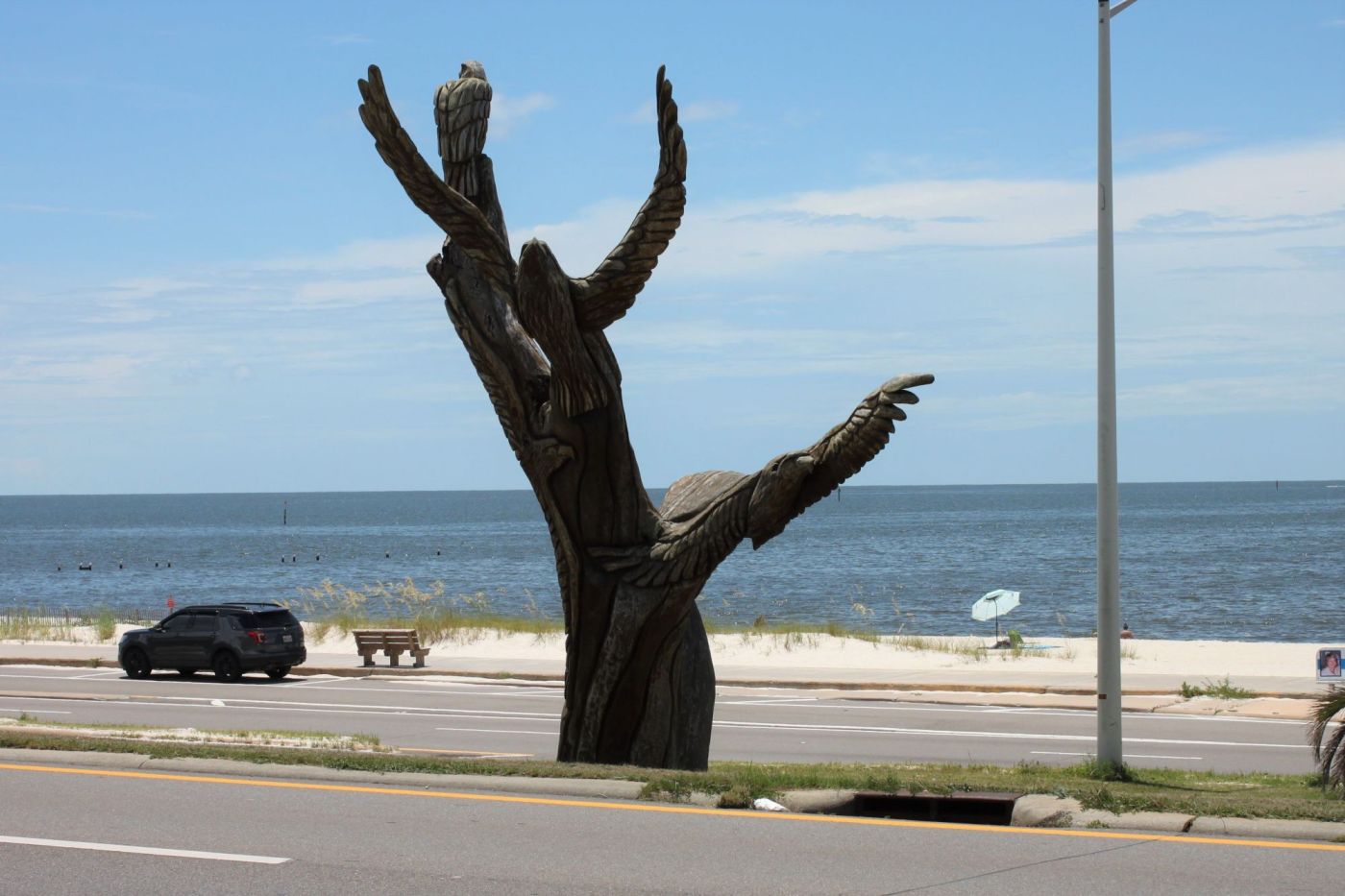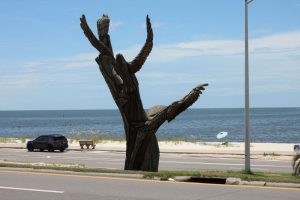
The Mississippi Gulf Coast beckons travelers in search of art, artifacts and history
By Caroline Eubanks | Chicago Tribune
The coastline of Mississippi is small but mighty, only 50 miles along U.S. Route 90.
But for generations, its communities have attracted visitors from near and far, first gaining popularity following the Civil War as New Orleanians hopped the trains and steamboats heading east to avoid yellow fever epidemics.
During this time, the six main towns along the route were given the name “Six Sisters of the Gulf Coast.” Today, the beach towns — especially Bay St. Louis, Ocean Springs and Biloxi — are favorites for travelers in search of sun, especially during the spring and summer months. The area has plentiful public beach access and, for those feeling lucky, casinos along the water, not to mention fresh local seafood hauled in every day. There’s also a rich history, with historic homes and museums focusing on the coastal ecosystem, like the Mississippi Aquarium and the Maritime & Seafood Industry Museum.
But what travelers might not know is that this area is also where many artists have settled amongst the Spanish moss-laden oaks for generations. For visitors seeking to incorporate the region’s art, artifacts and history into their travels, these three towns are laden with treasures.
Ocean Springs
Ocean Springs is straight out of a postcard, with a row of dramatic oak trees shading the art galleries and shops downtown. Italianate and Gothic Revival cottages dot the six historic districts in the city of about 18,000. Famed architect Frank Lloyd Wright even designed a bungalow in town for his mentor, Louis Sullivan, before it was destroyed by a hurricane.
The arts community is literally in the roots of Ocean Springs, where the clay is pulled out of the soil, specifically from the nearby Pascagoula River Basin. Shearwater Pottery (102 Shearwater Drive; 228-875-7320; shearwaterpottery.com) is one of the most notable artisans in the state, founded in 1928 by Peter Anderson with his parents, George Walter Anderson and Annette McConnell Anderson. Peter built the kiln and Annette purchased equipment from potter George Ohr’s estate, in nearby Biloxi, after his death.
They crafted hard-fired earthenware that is still highly sought-after, glazed in colors inspired by the coastline in hues of green, blue and brown. It’s still run by Peter’s children and the showroom on the Mississippi Sound offers visitors a chance to own a piece of this history, including plates, bowls, mugs and figurines of the animals that call the region home.
But the Anderson family legacy doesn’t end there. Peter Anderson’s son Walter became an artist in his own right, first working for Shearwater. The Walter Anderson Museum of Art (510 Washington Ave.; 228-872-3164; walterandersonmuseum.org) honors his work, including furniture he constructed for his home and colorful paintings of Mississippi flora and fauna. A highlight of the museum is the “Little Room,” a small paneled room with brightly painted murals featuring a day on the Gulf Coast from sunrise to sunset. Anderson kept it locked away from his family, who discovered the masterpiece after his death. Another wing features panels Walter Anderson was hired to paint for the Works Progress Administration with bold, geometric patterns.
He often escaped to Horn Island, one of the nearby barrier islands now part of the Gulf Islands National Seashore, for inspiration and solitude. The boat he rowed across the sound is one of many objects on display at the museum. Visitors can have the same transformative experience by renting their own vessel to make the journey or booking a tour with a charter company.
Walter Anderson’s work also influenced The Roost (604 Porter Ave.; 228-285-7989; roostoceansprings.com), a 19-room boutique hotel a few blocks away on a historic stretch of Porter Avenue with an outdoor pool and a speak-easy bar. Rooms are spread across two buildings and feature prints from his woodblocks, produced in collaboration with his family.
Lil’ Market Deli & Bagelry (720 Bellande Ave.; 228-300-4545; iheartbagel.com) is best for a bite on the go, enjoyed on a downtown bench or a boat trip to a barrier island. The mural-covered shop sells deli sandwiches piled high with Boar’s Head meats and kettle-boiled bagels.
Biloxi
Founded in 1699 under French rule, the Biloxi of today is most commonly associated with the brightly lit casinos that line the waterfront. But the arts community dates back over a century. Sculptor George Ohr, also known as the “Mad Potter,” began selling his wares as far back as 1879, opening his own kiln with local clay. He had a long mustache and his pieces bore his signature whimsical curves and ruffles.
Despite appearing at the 1904 Chicago World’s Fair, Ohr’s work didn’t come to prominence until after his death. His shop closed in 1909 after devastating losses due to theft and fire. It was untouched until 1972 when what remained was sold to a collector who grew his Ohr’s following in the New York City art scene. Ohr’s work is now displayed at the Frank Gehry-designed Ohr-O’Keefe Museum of Art (386 Beach Blvd.; 228-374-5547; georgeohr.org), with curved metal wings similar to Ohr’s pottery, nicknamed “The Pods.”
Some of today’s art set has moved west to downtown Biloxi, specifically the revitalized Howard Avenue corridor. The famed Zero Blues Club from Clarksdale, Mississippi, opened a Biloxi location in 2022 (814 Howard Ave.; 228-910-6600; groundzerobiloxi.com), hosting its signature live music and “Art in the Alley” arts market to highlight regional creatives.
Greenhouse (152 G.E. Ohr St.; 228-327-0579; biscuitsprings.com) settled down the street in 2020, bringing with it a rotating selection of local artwork plus fluffy biscuits and coffee served all day.
On the drive through town, one of the starkest visuals is what isn’t seen along the coast: homes. Thousands were destroyed during Hurricane Katrina in 2005, including 250 from the National Register of Historic Places. Some of the remaining trees, stripped of their branches, have since been transformed into artwork, carved into the likeness of dolphins, pelicans and other creatures that call the area home.
One of the few Biloxi buildings to withstand the storm was the White House Hotel (1230 Beach Blvd.; 228-233-1230; whitehousebiloxi.com), which started as a boardinghouse in the 1890s. After a decadeslong closure, it reopened in 2014 with rooms overlooking the gulf and a restaurant called Cora’s, named in honor of the hotel matriarch.
Bay St. Louis
Founded in 1818 for its location near the railroad, hotels and boardinghouses, the town of Bay St. Louis could be an extension of New Orleans with all of the art galleries, antique stores and cheerful murals. There’s no shortage of quirky annual events that bring out the creativity of locals like Frida Fest and Dolly Should, which honor Frida Kahlo and Dolly Parton with costume contests and art walks.
Folk artist Alice Moseley moved to the town in 1989 and got her start selling paintings depicting scenes of southern life at flea markets. After her death, her son opened a museum in her honor, the Alice Moseley Folk Art Museum (1928 Depot Way; 228-467-9223; alicemoseley.com), in the town’s former train depot.
Browsing the shops of the Bay, the creativity is seen in many forms, including artwork and locally made goods. The Shops at Century Hall (112 S. 2nd St.; shopsofcenturyhall.com) is filled with art galleries, vintage clothing and gifts. Clay Creations (105 S. Toulme St.; 228-466-6347; claycreationsllc.com) makes miniature versions of local landmarks from clay.
Locals and visitors alike gather at the Pearl Hotel (104 N. Beach Blvd.; 228-688-0400; pearlbsl.com), a 53-room boutique hotel with coastal-inspired décor. It features the Thorny Oyster, a popular restaurant highlighting the bounty of seafood in the area and proving that you don’t have to be artistically inclined to appreciate all that the Mississippi coast has to offer.
Caroline Eubanks is a freelancer.


